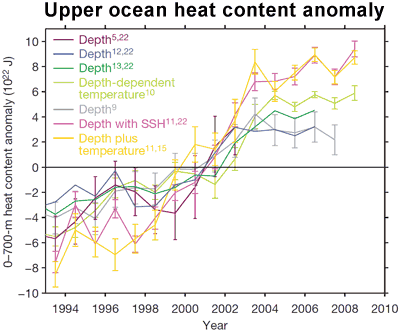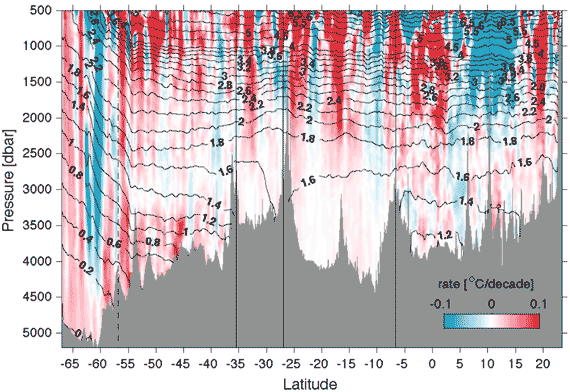Climate cherry pickers: cooling oceans
Posted on 11 November 2010 by John Cook
Most of global warming, over 80%, go into the oceans. So the amount of heat building up in the oceans is of great interest to climate scientists (and the rest of us climate wonks peering in from the sidelines). Some claim that the oceans are actually cooling, arguing that this proves global warming isn't happening. For example, one paper uses a reconstruction from Argo data as evidence that the oceans are cooling (Loehle 2008):

Figure 1: Ocean heat content smoothed with 1-2-1 filter and overlaid with linear trend (Loehle 2008).
However, this doesn't give you the full picture - there are a number of teams that have reconstructed ocean heat from the various datasets available. In an effort to create the most reliable measure of ocean heat, members from the various teams across the world combined their efforts into a single 'best estimate' of ocean heat (Lyman 2010). What they found was robust warming in the upper ocean over the 16 years from 1993 to 2008.

Figure 2: Ocean Heat Content anomaly from various teams. Ocean heat is calculated from 0 to 700 metres (Lyman 2010).
However, even this doesn't give you the full picture. These estimates are of heat content in the upper 700 metres of the ocean. Of course, the ocean goes much deeper than that. A fuller picture of ocean warming analyzes ocean temperature measurements by the Argo network, constructing a map of ocean heat content down to 2000 metres (von Schuckmann 2009). This finds significant ocean warming over the top 2000 metres of the ocean from 2003 to 2008.

Figure 3: Global ocean heat storage (0–2000 metres), measured in 108 Joules per square metre (von Schuckmann 2009).

Figure 4: Rate of ocean warming. Areas of warming are shaded in red and regions of cooling are shaded in blue with intensity scaled by the magnitude of the warming. The basins from south to north are the Southeast Pacific Basin, Chile Basin, Peru Basin, and Pacific Basin (Purkey & Johnson 2010).
To properly understand what's happening with ocean warming, you need to take in the full picture. This means all the data and the whole ocean, not just the upper 700 metres. To claim the oceans are cooling is to ignore the full body of evidence.































 Arguments
Arguments






























What Trenberth is trying to do is fit data to data, not theory to data. Eg - he has two metrics of the same phenomenon - the planetary energy imbalance. One is measured by satellites which measures energy coming in and out, the other by the accumulation of ocean heat. Satellites find that the planet's energy imbalance has gradually been increasing. So had ocean heat until around 2005. Note that ocean heat measurements still find a positive energy imbalance - the planet is still accumulating heat - just not as much as the satellite data at the moment.
Scientists are scrutinising both the satellite and ocean data even as more data comes in and I expect the discrepancy will be resolved over the next few years. Here on the blogosphere where we breathlessly monitor monthly updates to every climate metric imaginable (guilty as charged), the long wait for resolution is a little painful.
- The observed imbalance is 6.4 W/m2
- This observation is inconsistent width model calculations
- Therefore observed imbalance is crap, models must be correct
"There is a TOA imbalance of 6.4 Wm-2 from CERES data and this is outside of the realm of current estimates of global imbalances (Willis et al. 2004; Hansen et al. 2005; Huang 2006) that are expected from observed increases in carbon dioxide and other greenhouse gases in the atmosphere. The TOA energy imbalance can probably be most accurately determined from climate models and is estimated to be 0.85 ±0.15 W m-2 by Hansen et al. (2005) and is supported by estimated recent changes in ocean heat content (Willis et al. 2004; Hansen et al. 2005)." It is non sequitur at its finest. A 6.4 Wm-2 is of course impossible (it happily belongs to the "Had I had three legs it would not have gone unnoticed" category). But from the fact a particular kind of measurement (satellite measured imbalance at TOA) is unreliable, there is no legitimate way to conclude another estimate (quasi-theoretical inference using computational climate models) is correct. The best we can say is it's either correct or not. As it is also inconsistent with ARGO OHC measurements, it suggests ARGO is either crap or not. Trenberth is only willing to consider the former possibility, but the latter one (implying computational climate models are seriously flawed) is a very real possibility at the moment.The key here is that you've used sea level at a single location to infer there's no "wide spread warming". A single location is not a good indicator of global sea level as individual locations can be influenced by local subsiding rates, tectonic uplift, varying rates of thermal expansion due to regional ocean warming, etc. A better metric for "wide spread warming" is global sea level:
For more info, see our page on sea level rise.